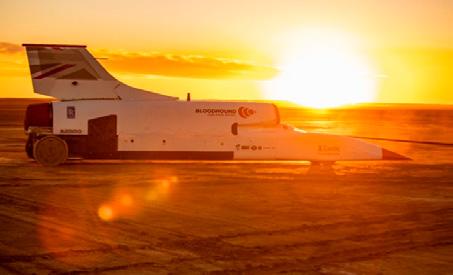
4 minute read
Engineering
Fast cars and superfast data are set to break records.
Photo: SARAO; NRAO/AUI/NSF
Advertisement
Most engineering work in the Northern Cape is done on or around mines. But the construction of a new university from scratch, a landspeed record attempt and a vast international radio telescope project are putting advanced engineering at the forefront of activity in the province.
The bulk of the new structures for the Sol Plaatje University were subject to a competition. From a total of 59 entries, nine architectural firms were selected to enter the second round of the competition with five firms chosen as winners to complete different aspects of the project.
The Sol Plaatje University Library and Student Resource Centre earned Aurecon an award at the 2018 CESA Aon Engineering Excellence Awards. The building on South Africa’s newest campus in Kimberley also won a Fulton Concrete Award. It was designed by designworkshop: sa, the construction work was done by Murray and Dickson and Aurecon’s brief was structural, civil, electrical, fire and wet services design.
Another striking building, designed by Savage + Dodd, was “highly commended” at the World Architecture Festival. The multi-purpose building encompasses a residence, offices, meeting spaces and retail space on the ground floor.
The long-anticipated attempt on the world landspeed record moved a step closer with tests conducted early in 2020 at Hakskeenpan. The flat stretch of dusty land chosen for the attempt by a team called Bloodhound is not far from Verneuk Pan, where Sir Malcolm Campbell failed to go beyond the record of 370.4km/h in the Blue Bird in 1929.
The record now stands at 1 227.9km/h and the feat of engineering required to propel Andy Green (who holds the record) past that speed is awesome. Speeds above 1 000km/h were achieved during tests, but the focus was on how the car reacted to desert conditions. The car has been described as a combination of a rocket, a Formula 1 car and a jet aircraft. An extensive local project, in which 317 members of the Mier community cleared the track, was funded by the Provincial Government of the Northern Cape.
High-level science and engineering underpin the Square Kilometre Array Radio Telescope (SKA). Unimaginable amounts of data are set to be collected in this transformative radio telescope project that is centred on Carnarvon but has global reach.
The data that the SKA will collect in a day would take twomillion years to play back on an iPod. The radio telescope’s image-resolution quality will exceed that of the Hubble Space Telescope by a factor of 50.
The SKA will be the world’s largest radio telescope, made up of thousands of antennae
Sector Insight The South African Institute of Electrical Engineers has launched a branch in Kimberley.
throughout Australia and Africa. In 2019, 15 countries involved in the SKA project gathered in Rome for the signing of the international treaty establishing the intergovernmental organisation that will oversee the delivery of the world’s largest radio telescope. This is the Square Kilometre Array Observatory (SKAO), which is tasked with delivering and operating the SKA.
In South Africa, the South African Radio Astronomy Observatory (SARAO), a facility of the National Research Foundation, manages all radio astronomy initiatives and facilities, including the MeerKAT radio telescope in the Karoo.
To maximise the return on South Africa’s investment in radio astronomy, SARAO is managing programmes to train people in radio astronomy science and engineering research and is building the technical capacity to support site operations. Some of the Large Survey Projects (defined as requiring more than 1 000 hours of telescope time over five years) being undertaken via MeerKAT are the hunt for dynamic and explosive radio transients (ThunderKAT) and observations of nearby galactic objects (Mhongoose).
Great results were achieved in December 2019 when rare, bright “starburst” galaxies never previously observed in radio light were observed by MeerKAT. A composite photograph is shown on the previous page.
The Renewable Energy Independent Power Producer Procurement Programme (REIPPPP) has created an entirely new industry in less than seven years, with investment of about R200-billion in solar parks and wind farms. This has created many opportunities for engineers, many of which are in the Northern Cape.

Photo: Charlie Sperring
New spark in Kimberley
The South African Institute of Electrical Engineers (SAIEE) has launched a new branch in Kimberley. The SAIEE Northern Cape Centre will attend to the needs of members and hold events of interest related to electrical or electronic engineering. SAIEE has 6 500 members around the country and is registered as a non-profit voluntary association with ECSA (Engineering Council of South Africa).
An important body in the South African context is the Institute of Municipal Engineering of Southern Africa (IMESA), which has more than 1 000 individual and company members. A key focus for the body is to provide training in sustainable infrastructure asset management, something that has proved a challenge for many municipalities.
Engineers continue to be critical to the work of the mining industry in the Northern Cape. Aveng company Moolmans reported good results in 2019, partly on the back of renegotiating the contract to work on the Gamsberg zinc project.
ELB Group’s Engineering Services division employs more than 1 000 people and the company is currently working full-time on the vast Gamsberg zinc project. Manganese, iron ore and coal are other mining sectors where ELB is active. ■
Online Resources
Consulting Engineers South Africa: www.cesa.co.za Institute of Municipal Engineering of Southern Africa: www.imesa.org.za South African Institute of Electrical Engineers: www.saiee.org.za South African Radio Astronomy Observatory: www.sarao.ac.za Southern African Institution of Civil Engineering: www.civils.org.za









